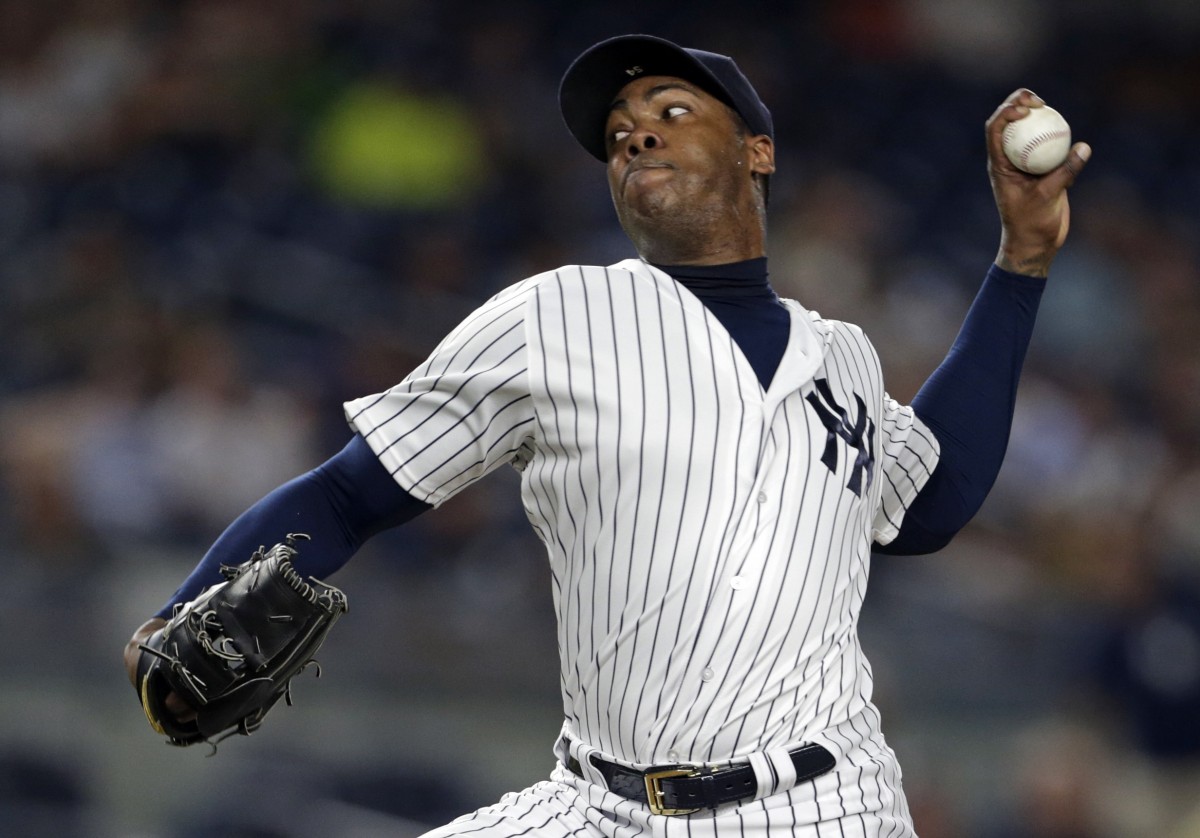There are two different types of pain tolerance. The first is how much pain a person can handle in one single blow, or the “how much?” The second involves managing prolonged or repeated pain, or the “how many?” When a player gets hit by a pitch, it’s a matter of the first kind of pain tolerance: the “how much?” This will vary depending on the location and velocity of the pitch. When Aroldis Chapman is pitching, it is the truest test of pain tolerance in baseball. Unfortunately for Jackie Bradley Jr., his adventures with Chapman have tested the limits of “how much?” as well as “how many?”
Last night, Chapman drilled Bradley with a 103.3 MPH fastball. Nearly every sports media outlet chronicled how this was the fastest pitch in MLB this season, and that Bradley was tragically unlucky to take it on the elbow.
(Here’s a link to a gif of it because we can’t embed tweets for some reason.)
But the history of these two All-Stars goes deeper. In 7 career plate appearances against Chapman, Bradley is 2-3 with a walk and 3 HBP! On one hand, kudos to Bradley for reaching base 6 out of 7 times against perhaps the greatest lefty reliever of all time. On the other, that is NOT a sustainable way to reach base, let alone extend one’s career. Let’s examine these HBP a little further.
A (Very Painful) Trip Down Memory Lane
August 13, 2014: The first pitch Bradley ever saw from Chapman came up and in at 100.8 MPH. Bradley couldn’t get out of the way and got plunked. No, he didn’t; he got drilled. Plunked is what happens when a batter gets hit with a curveball or changeup. Chapman has never plunked anyone in his life. 2014 was Bradley’s first full season, and this was the first 100 MPH fastball he’d ever seen in the majors (and probably ever).
August 13, 2017: Three years to the day after the first HBP Chapman nailed him again, this time at 101.5 MPH on an 0-2 count. StatCast actually recorded the exit velocity at 51.7 MPH. That’s not the exit velocity off a wooden bat, that’s off bone and sinew! The ball traveled a distance of 43 feet. At the risk of being immodest, this is the single greatest application of StatCast in history.
May 8, 2018: 103.3 MPH, as shown above. This is the fastest velocity on a HBP ever recorded by StatCast, breaking the previous record of 102.7 from Chapman to Khris Davis on August 24, 2013. One would think after three near-assassinations, Bradley and Chapman might have words (or fists) to share with one another. Instead, Bradley simply takes his base, and Chapman walks toward him presumably to apologize or check that he’s OK. We don’t often get to congratulate ballplayers for showing maturity. Well done, gentlemen.
Bradley’s Terrible HBP Misfortune
This was not supposed to happen. Neither Bradley nor Chapman are prone to HBP (thank goodness). Bradley has faced 8,216 pitches in his MLB career and he’s only been hit by 34 of them (0.41%). Chapman is one of the most dangerous pitchers on the planet simply because of his blistering fastball, but he’s only hit 21 batters with 7,633 pitches (0.28%). Averaging the two, a pitch thrown from Chapman to Bradley should result in a HBP only 0.35% of the time or once every 286 pitches. In actuality, 3 out of 23 pitches have left a bruise.
However, not every pitch by Chapman reaches triple digits. He throws a lot of sliders and plenty of fastballs that only reach the high 90s. Roughly 1/3 of Chapman’s pitches cross the 100 MPH threshold (35.6%), so the chances of Bradley getting hit with a 100 MPH Chapman fastball are only 0.12%. Mathematically, it should happen once every 805 pitches, but in real life, it’s been once every 8!
Other pitchers have thrown 100 MPH, but last night’s 103 MPH high cheese was truly rare even for Chapman. He’s only thrown 262 pitches in his career at that speed or higher, which is 3.4% of all his pitches. Before last night, no one had ever been hit by a 103 MPH pitch. Based on the HBP rates of both Chapman and Bradley, it should happen once every 8,347 pitches from the former to the latter. Unfortunately for Bradley, it happened on just the 23rd.
Bradley has paid his dues against the Cuban Missile. The odds of getting struck 3 times in just 23 pitches by the hardest thrower in baseball history are unbelievably long. It’s highly unlikely to happen ever again. However, next time he faces Chapman he should consider standing a few inches further back in the batter’s box.
Photo Credit: Adam Hunger-USA TODAY Sports
